The Essential Concepts of Describing Form
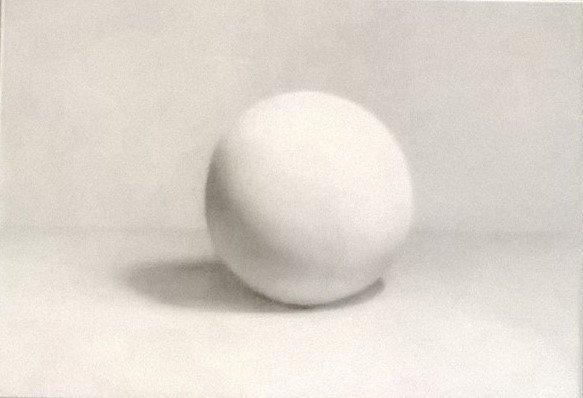
Greetings and salutations Everyone!
In this post I’ll be discussing the principles of describing form, how light behaves, and how to go about interpreting what we see in the efforts creating the illusion of volume in three dimensional space. Surprisingly enough, in firmly understanding these relatively simple concepts, a small amount of visual information can convincingly go a long way.
So in this lesson I thought it would be best to use my own example of what we called “the sphere project” while I was studying at The Aristides Atelier. With this project we learned how to turn form and in using my own experience I thought it would be best in that I could easily narrate what I was thinking and how to go about constructively accomplishing this goal.
First off what you’re going to need is a sphere ( roughly 4 or 5 inches in diameter) for reference. One of those round Christmas tree decorations spray painted white are ideal. No matter what it is, remember that it has to be smooth and spray painted a flat white. No gloss. When you set it up all you have to do is point the hook part away from you so that it is out of sight.
You’ll then of course need a shadow box. A shadow box is basically a large box that creates an environment that is independent of any random or adverse light sources. A shadow box keeps the lights, values, and shadows consistent throughout the completion of the project. It doesn’t matter what it is made of as long as it’s large enough for the light source and that it is sturdy. It is also best if the “box” where to be spray painted a flat gray, say a value 6 on the value scale.
And of course you’ll need a light source for the sphere. A goose neck lamp works well for this. The temperature of the light doesn’t really matter at this point as we’re only dealing with value right now.
When you’re adjusting your light source, you’re going to want to think it about it in terms of it coming from a 45 degree angle on its side and 45 degrees inwards towards you. If you’re off a few degrees it’s not the end of the world, but remember that it would be wise to uphold this as a standard ideal to strive after. This concept of lighting is commonly known as “Traditional Lighting” or “Rembrandt Lighting”. Lighting it from the opposite side (where the light reads from right to left) is what as known as “Sinister Lighting”. This is also acceptable.
You also want to be aware of the intensity of the light source. In an abstract manner, light is essentially the predominant subject in all great works of art. If there is not enough light, forms and shapes become flattened. If there is too much light, things obviously are washed out and there’s no midtones and shadows. What you’re wanting to look for here is a wide range of values. Strong shadows and strong lights.
(Along time ago there were many artists who believed that like reading, writing, and understanding language, light was best depicted, appreciated, and understood as reading from left to right. While psychologically/emotionally I feel like it might have some merit, at the same time there have been many great painters later on that proved the antithesis of that concept to have worked just as well.)
For the drawing materials, besides for of course an easel and a drawing board, the paper I recommend is Strathmore’s #500 (NOT the gray toned pack) and Nitram Charcoal (A box of the hard grade and one of the soft grade. One’s blue and one’s green the last time I checked). You gotta love Nitram. It is easily the best stuff there is out there. There are a few other brands of willow and vine that are decent, but compressed charcoal is something you’re gonna want to avoid for this exercise. While both sides of the paper are acceptable, I recommend using the back as you’ll have an easier time not battling the weave of the paper.
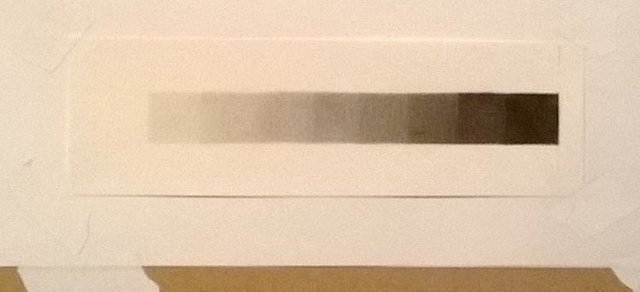
(Before I began setting up the sphere, I first created a value strip in charcoal consisting of the standard 9 values. This will serve as a guide in simplifying, rendering, and compressing values. I'd actually recommend doing a couple of these before beginning. Believe it or not, they're kinda fun!)
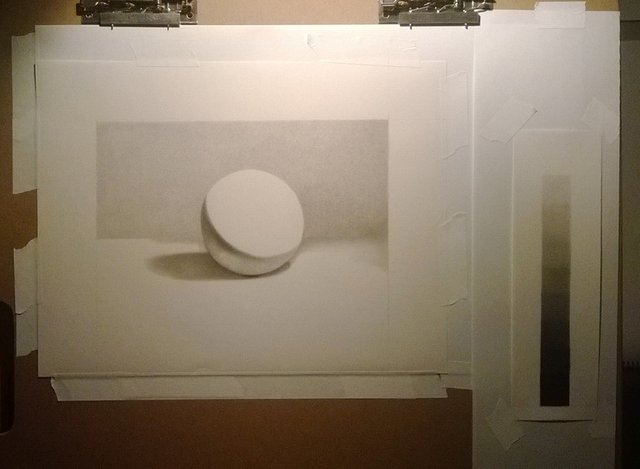
Of course from observation, I began to draw the armature (wire drawing) of the sphere, core shadow, ground plane, and cast shadow. For the sphere itself, you can use something as simple as a coffee cup. It doesn’t have to be exact, although I’d avoid the extremes. I wouldn’t want you to be working on a giant sphere and the one you’re referencing to be small, or vice versa.
I then began to mass in the core shadow and background at the same time with a false tone. The main reason as to why I chose to do the background at the same time is because it helped to alleviate some of the issues when working on a white surface. When one stares at the white paper, the pupils have a tendency to constrict which makes it much harder to judge values accurately.
I also chose to keep the ground plane as close to eye level as possible. Doing this alleviates potential perspective issues in the future. Keep in mind that this nifty little trick will save you from many headaches when attempting to draw ellipses and other man made objects. I would’ve brought down the ground plane even further, but at the same time I wanted to preserve the aesthetically pleasing shape of the cast shadow. I then began to lightly mass in the cast shadow. Cast shadows are wonderful in that they attach the object to the ground plane. They give weight and solidity.
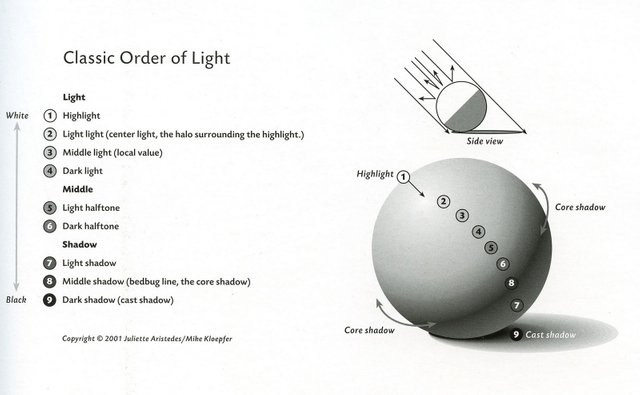
This image above I believe shows an excellent and simplistic idealization in how form and value should be perceived and exercised. Theoretically, there are many many more gradations in value, but remember that simplification is key here. By simplifying or reducing the amount of information to a value scale such as this, allows for a more believable description of form.
In the next step I chose a spot on the terminator line (as you can see in the lower left of the sphere) and began to aesthetically embellish it by increasing its value. At this current stage of the exercise I believe it is important to point out that you want to be mindful of the elusive value of the reflected light. It has a tendency to appear lighter than it really is. As the form turning progresses and you have a greater range of comparison, the greater perspective you’ll have in the value’s continuity.
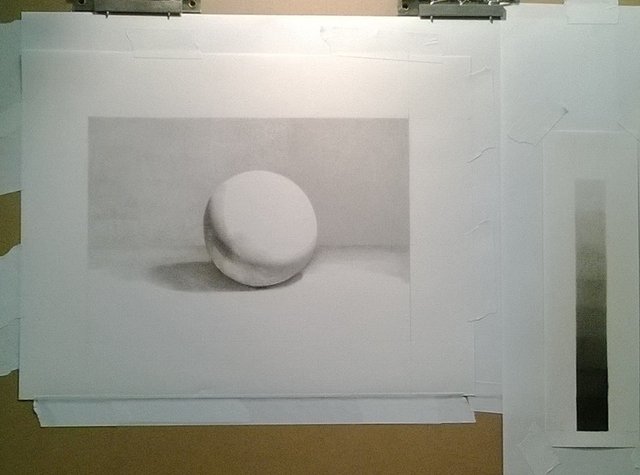
Now that I have emphasized the value of the terminator line, I began to turn my darkest of lights ACROSS the form and into the light. This is of the utmost importance! I do realize that for beginners that it takes quite a mental shift to think in this way, but it is imperative in that you understand the difference between turning across the form and along the form. Many beginners try to get away with attempting to move along the core shadow and all it does is create a bunch of unwanted bands. This is what you absolutely want to avoid. Remember to ALWAYS move ACROSS the form, feeling its roundness and giving it a sense of volume. Believe me, it’ll pay off in the end.
Now that you’ve initially rendered all the way into the light, once again go back to the core shadow right next to where you were before and repeat the process. In a nutshell you’ll basically be doing this until the sphere is fully turned. Take special note though as there eventually comes a moment where one realizes that the speed in which the gradation of value changes depending on where you start on the sphere. It is also important to refrain from creating a uniformly clean cut core shadow shape. Take special notice in the subtle nuances and shifts in lost and found edges. Keep in mind that sharp edges come forward and soft edges recede.
The strange thing about turning form is that it not only takes great patience and focus, but requires strength and dedication in its method until one can actually see its accumulative payoff.
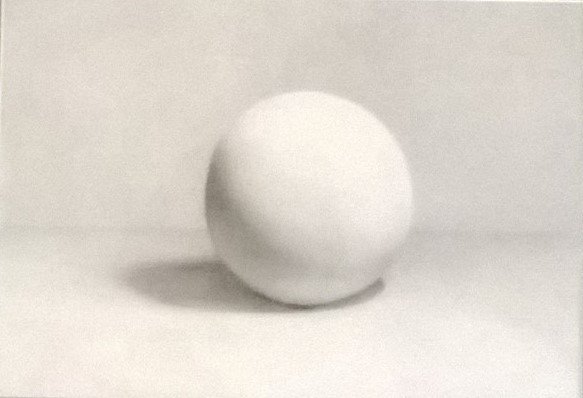
And once again here was the finished product!
After finishing the sphere I then began to work on the foreground and cast shadow. The wonderful thing about rendering cast shadows is that they're not quite treated the same way as core shadows. They're fun in a way where you have a little more room in maneuvering them. Here I ended up extending its penumbra (the shadows outer edge) to give it a more aesthetically pleasing look. Even though that this part is optional, there is something about it that attracts the eye.
Well I hope it was a pleasure reading this post as much as it was for me writing it.
Please feel free to let me know what you think?
Thanks for reading Everyone!
-James Hansen
https://jameszenartist.weebly.com/
Following youuuuuuuuuuuuuuuuuuuuuuuuuuuuuuuuuuuuuuuuu
wonderful post! this deserves a lot of merit.
basics are just the core of art.
good youre sharing!
upvoted!
Downvoting a post can decrease pending rewards and make it less visible. Common reasons:
Submit
@jacinta.sevilla isn't he amazing? :) glad he really started blogging here.
Downvoting a post can decrease pending rewards and make it less visible. Common reasons:
Submit
Yes @ablckbrd we need awesome artists here on steemit! :D
@jameszenartist Thanks for being awesome haha youre welcome :D
lets continue our art journey!
Downvoting a post can decrease pending rewards and make it less visible. Common reasons:
Submit
Thank you so much Jacinta, I really appreciate it. I'm glad you find it helpful. :)
Downvoting a post can decrease pending rewards and make it less visible. Common reasons:
Submit
this is great. deserves an upvote.
Downvoting a post can decrease pending rewards and make it less visible. Common reasons:
Submit
Thanks a lot @ritzzard I really appreciate it :)
Downvoting a post can decrease pending rewards and make it less visible. Common reasons:
Submit
no problem. looking forward to more of your future post. I really want to learn more from you. and thanks for sharing this. :)
Downvoting a post can decrease pending rewards and make it less visible. Common reasons:
Submit
You're very welcome :) I'm attempting to keep it at a pace where I'll put up blog posts like these every few days or so..so stay tuned! ;)
Downvoting a post can decrease pending rewards and make it less visible. Common reasons:
Submit
Very nice artwork. I will be following you!
Downvoting a post can decrease pending rewards and make it less visible. Common reasons:
Submit
Thank you! :)
Downvoting a post can decrease pending rewards and make it less visible. Common reasons:
Submit
so beautiful
Downvoting a post can decrease pending rewards and make it less visible. Common reasons:
Submit
Thank you! :)
Downvoting a post can decrease pending rewards and make it less visible. Common reasons:
Submit
Very helpful and indepth tutorial. Almost like I had a private lesson with you! :) I had no idea about many things that you wrote about. Thank you very much for sharing your professional insight.
Downvoting a post can decrease pending rewards and make it less visible. Common reasons:
Submit
Thank you so much, I really appreciate that! That's actually the kind of thing I was going for, so I suppose it's a mission accomplished! ha!
Downvoting a post can decrease pending rewards and make it less visible. Common reasons:
Submit
James! I am learning so much from you! Thanks for your generosity! :) Amazing article as always!
Downvoting a post can decrease pending rewards and make it less visible. Common reasons:
Submit
You're very welcome! ^__^ I'm glad you find it helpful. Writing this kind of stuff is good practice I suppose :P I wanted to be as clear as possible but at the same time there is just sooooo much information I want to delve into. I'm finding it very difficult in keeping these posts from turning into novels. ha!
Downvoting a post can decrease pending rewards and make it less visible. Common reasons:
Submit
James! You are amazing! Your posts are always upvoted by @curie :)
P.S. I dont mind reading long posts from you!
Downvoting a post can decrease pending rewards and make it less visible. Common reasons:
Submit
Why thank you so much ^___^ That really means a lot to me and I enjoy reading your comments and knowing that what I can teach you find beneficial. You're the kind of people that are the reasons as to why I'm doing this. It's taking a lot out of me but I'm really enjoying it :) Please feel free to ask me questions or make suggestions about what you'd like me to write about in the near future?
Downvoting a post can decrease pending rewards and make it less visible. Common reasons:
Submit
Excellent explanation for those who start in the drawing. I follow you
Downvoting a post can decrease pending rewards and make it less visible. Common reasons:
Submit
I appreciate what you're doing, good job! :)
Downvoting a post can decrease pending rewards and make it less visible. Common reasons:
Submit
so beautiful
Downvoting a post can decrease pending rewards and make it less visible. Common reasons:
Submit
Thank you ^__^
Downvoting a post can decrease pending rewards and make it less visible. Common reasons:
Submit
welcome dear
plz upvote me
Downvoting a post can decrease pending rewards and make it less visible. Common reasons:
Submit
Good Post Friend
Downvoting a post can decrease pending rewards and make it less visible. Common reasons:
Submit
Thanks a lot man :)
Downvoting a post can decrease pending rewards and make it less visible. Common reasons:
Submit
one part of art making thats so hard
SAND
and how to paint it digitally/ traditionally
using watercolor, colored pencils, graphite, acrylic or oil
thats one of the most difficult ever with hyper realism, i cant achieve it.
Downvoting a post can decrease pending rewards and make it less visible. Common reasons:
Submit
In the beginning, I can understand how it can be overwhelming. But if I were you I wouldn't get caught up in the medium you're using, it's simply a vehicle. Once you have the core skills down, You'll do just fine ;)
Downvoting a post can decrease pending rewards and make it less visible. Common reasons:
Submit
yes but, it has to have resemblance to the subject.
If you have tips id love to learn :)
Your art is so fine and smooth! youre very talented!
Downvoting a post can decrease pending rewards and make it less visible. Common reasons:
Submit
Oh yes of course :) Believe me, there will be many more posts like these in the near future. Thank you, you're very kind ^_^
Downvoting a post can decrease pending rewards and make it less visible. Common reasons:
Submit
Congratulations @jameszenartist! You have completed some achievement on Steemit and have been rewarded with new badge(s) :
Click on any badge to view your own Board of Honor on SteemitBoard.
For more information about SteemitBoard, click here
If you no longer want to receive notifications, reply to this comment with the word
STOPDownvoting a post can decrease pending rewards and make it less visible. Common reasons:
Submit